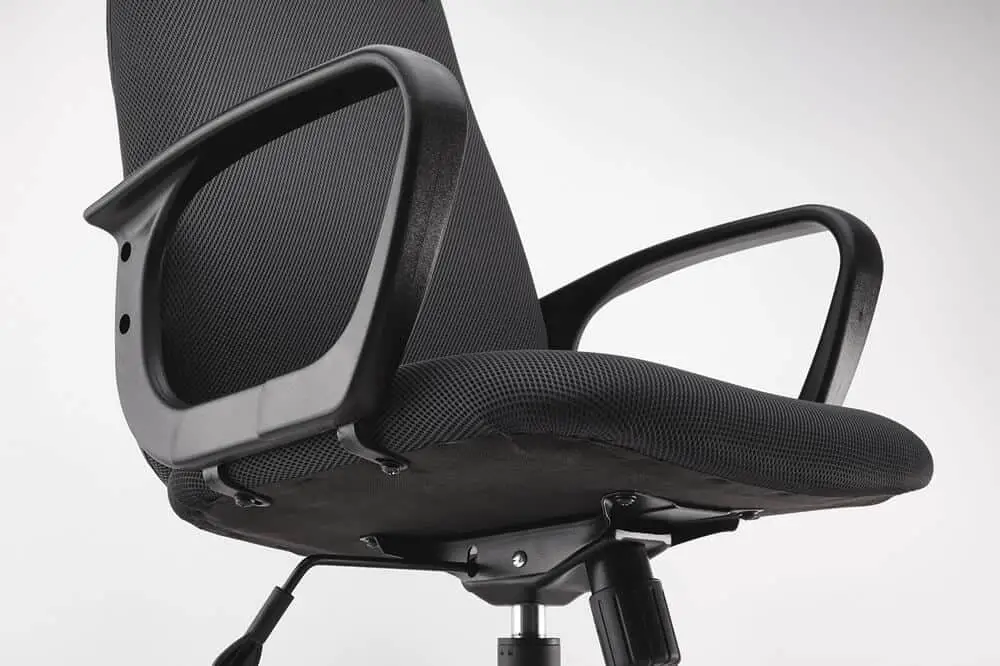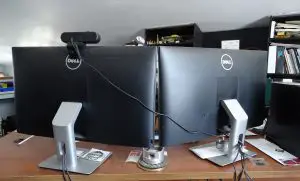Wouldn’t you agree that having an amazing ergonomic office chair gets you much more excited on Monday mornings? We sure do! As full-time writers spending a lot of time sitting in front of a computer desk, we understand first-hand how important it is to have a reliable office chair.
How are office chairs made? An office chair is made by creating a steel frame for the base and the backrest. After the steel frame is created, the upholstery is made by sewing the foam padding with the chair’s primary material (leather, fabric, or mesh). The office chair is then assembled accordingly.
At Office Solution Pro, we are passionate about Ergonomics! Our readers support the page. If you click on a link, we may earn a small commission at no cost to you. We hope you love the products we recommend as much as we do!
With that said, there is a lot of historical significance to this amazing office furniture. We think it’s time to get to know your office companion better. In this post, we’ll dive deeply into how an office chair is made. You’ll be surprised at what goes into making one of them.
A Brief History of the Office Chair
Office chairs, also known as desk chairs, were developed around the mid-19th century as more workers spent more time sitting behind a desk, leading to the development of features not found on regular chairs. It wasn’t until the 1970s that ergonomics became an important design consideration.
Did you know that Thomas Jefferson, one of America’s founding fathers, came up with the first swiveling mechanism for office chairs? The swivel office chair is believed to be the chair on which he drafted the United States Declaration of Independence in 1776.
Decades later, Charles Darwin added small wheels called “casters” to his chair to move it around while working on the theory of evolution. According to this report, Charles Darwin put wheels on his office chair while studying to get to his specimens more quickly.
Today, office chairs still swivel and roll, thanks to the amazing inventions of two great historical figures. As an office chair has become a status symbol in modern society, executive versions of these office chairs come in kingly dimensions. They’re extremely plush and have serious lumbar support.
What Are Office Chairs Made Of

What are office chairs made of? There are several types of office chair materials available, including fabric, leather, mesh, plastic, and wood. Each material has its pros and cons. Part of choosing the best chair is understanding its material. With that in mind, here’s the list of the best office chair materials available:
1. Fabric
Fabric office chairs usually come in two kinds, woven and knitted fabric. These office chairs are the most common type in offices worldwide. While it’s very attractive and comfortable, fabric material is susceptible to liquid. Just be sure to clean your chair properly should you experience any spillage while working.
2. Leather
Leather office chairs, especially the executive versions, embody office luxury. Nonetheless, these chairs may come at a higher price compared to their fabric counterparts. Some companies choose synthetic leather to make them more affordable for their customers.
3. Mesh
Mesh has become a very popular material for office chairs. Mesh office chairs usually come in an ergonomic shape to support the back. Because of their flexibility, this material is very breathable as they bring airflow to the user when seated. Nowadays, the best sellers in today’s market are made with mesh.
4. Plastic
Plastic office chairs usually don’t have features to support the user for long-time sitting. However, they are very compact and built for affordability. Often used in waiting rooms and common areas, these chairs come in a variety of colors and designs. Plastic chairs are cheap enough to be replaced regularly.
5. Wood
In today’s modern society, wood office chairs have become hard to come by. Known as one of the most traditional chair material, wood is considered very artisanal. However, wood office chairs lack ergonomic features and don’t support the user well for long hours of sitting.
How an Office Chair is Made
Before you read the breakdown of how office chairs are made, watch this short video to get a visual idea of what goes into making a Herman miller office chair:
1. Creating the Structure
The entire process starts with the creation of the structure of the office chair. Using a hydraulic-powered machine, a worker bends 14 gauge steel tubing to form the bottom cushion frame. The worker then joins the ends and welds steel bars to the middle. The bars will support the mechanism for adjusting the position of the seat.
The worker continues by hooking S-shaped steel springs from the front to the back of the steel frame. These sinuous springs will eventually provide a flexible web of suspension in the seat. The rods are positioned laterally and clipped to the springs for additional stability and support. The office chair seat frame is now complete.
Next, a worker starts building the office chair’s back frame. The frame includes a lumbar spine support, armrests attachments, and other parts depending on the design. The worker then grinds spurs and other rough spots from the steel. Combining the seat frame and the back frame, the structure is finished.
2. Creating the Upholstery
In the upholstery department, another worker smoothes the leather hide, so it sits evenly on the cutting table. The worker cuts out the patterns following cardboard templates. As the worker cuts, he works around the natural flaws in the hide, making calculated decisions to minimize waste.
By cutting carefully, the worker can get the leather needed for one chair from a large piece of hide. This is an important part of the manufacturing process because color and grain can vary from hide to hide. Using pieces from the same hide will give the chair a consistent look and texture.
Once all of the leather pattern pieces have been accumulated, another worker cuts foam cushioning for the backrest. The density of the foam in the chair varies. The worker will use more rigid foam for the chair’s contoured cushioning, so it will hold its shape.

The worker has to make calculated decisions when cutting the leather hide to ensure uniformity.
Another worker selects softer foam for backrest cushioning. Depending on the design, the worker will cut slits into the softer back padding. This creates channels that will ultimately become a design feature. Using chalk, he draws lines to the corresponding leather that matches the slits on the foam.
A different worker will then align the chalk lines in the leather with the slits and puckers the leather as he sews the backing. This forms a ribbed pattern in the upper half of the office chair upholstery. The worker stitches the padding flat to many of the other pattern pieces. This particular part is the side panel for the back of the chair.
Returning to the upholstery with the ribbing, the worker will sew contoured casings to each side. To complete the backrest of the office chair, several workers add a chipboard panel and encase the structure with foam. The workers then cover it with leather upholstery. The upholstery is now complete.
3. Final Assembly
Once the chair seat has been upholstered, an employee installs a plastic cover to enclose the back. The employee screws a sliding plate to the base. This mechanism will work with the plate to slide the seat forward and backward, depending on legroom needs. It also has features for adjusting the tilt and height of the seat.
Next are the hydraulic cylinders for adjusting the seat height. It’s important to take extra care during this process to avoid unwanted accidents for the user. The cylinder also doubles as the office chair’s stem. It also swivels to allow the seat to rotate 360 degrees. The employee attaches the aluminum base to the cylinder and snaps the caster into slots in the aluminum base.
If the office chair is designed with an automobile-style headrest, the worker will fit prongs into the backrests in the chair frame. Finally, the worker locks the armrests into the frame. Voila, one leather office chair is ready to make someone’s desk job much more comfortable.
Fun Facts About Office Chairs
1. We spend up to 17,000 hours sitting in our office chairs. According to the National Post, the average office worker sits for about 10 hours daily. If you consider that the average American work 1,700 hours a year, this means office workers may spend up to 17,000 hours sitting in office chairs. That’s crazy!
2. Research suggests an ergonomic office chair boosts productivity by 17.5%. The University of Southern California found that productivity could be increased by simply providing workers with the right chair and training. Be sure to choose the best ergonomic office chair to promote healthy sitting!
3. The Herman Miller Aeron is considered the best-selling office chair on the planet. When Designers Bill Stumpf and Don Chadwick were designing the Aeron Chair, they were thinking about what hadn’t been done before and what ultimately made individuals want to sit in a chair.
The remastered Aeron won the “Good Design Award” in the Furniture and Lighting category by the Industrial Design Council of Australia. From aesthetics to comfort and design, the Herman Miller Aeron Chair is at the very top of its class and has become the quintessential ergonomic office chair today.
Notable Quote
“Sitting is to be thought of a compromise position since man in his natural habitat functions best when he is either erect and moving or supine and resting… Many of our ailments are by-products of sitting.”— American industrial designer and ergonomics pioneer, Niels Diffrient
Final Words
As the world has evolved over the years, so does the way we work. Because many of us work from home, taking the time to understand how office chairs are made can help you decide the best option. Choosing the best ergonomic office chair can help you maximize productivity every day. 🙂






